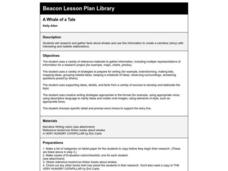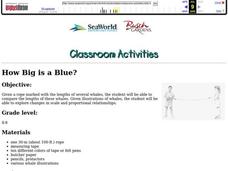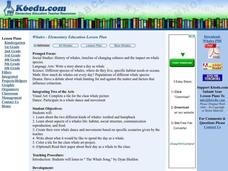Curated OER
Echolocation and Communication: Body Language Charades
Students participate in a variation of the game charades to explain how whales use their bodies to communicate.
Curated OER
A Whale of a Tale
Students read "A Very Hungry Caterpillar" and discuss factual information in the book. They research whales and use information to write a narrative story. They take their stories through the writing process.
Curated OER
HOW BIG IS A BLUE?
Students compare the lengths of whales using different lengths of rope. They illustrate one whale in life-size proportion.
Curated OER
Whales
Second graders identify the role of whaling in ancient Hawaii and the role of whales in Hawaii today, identify the migration route of whales and identify the whales that migrate to our Hawaiian waters.
Curated OER
W for Whales
In this whales worksheet, students read several texts whales. Students read informational facts about the mammal and a poem.
Curated OER
W for Whales
In this whale worksheet, students complete a word scramble, word search, word find, and word creation activity that relates to the whale.
Curated OER
Whales
Students study the history of whales. In this whale lesson plan, students research two types of whales, color a tile, and write a one page paper. The tiles may be combined to make a group picture.
Curated OER
Whale Data Cards
In this whale facts activity, students cut out the whale cards and fill them out with information that includes the whale type, length, weight, diving depth, and geographic range.
Curated OER
Whale Activity Sheet
In this science learning exercise, students study whale species by first examining the 6 drawings and matching them to the species names in a word bank. Students also answer 6 true/false questions about whales. There is no information on...
Curated OER
Whale World Coloring Sheet
In this coloring worksheet, students decorate a ship that illustrates a whaling ship similar to those that can be found at the Whale World historic whaling station in the state of Washington.
Curated OER
Easy Whales Crossword Puzzle
In this vocabulary worksheet, students examine facts about whales by solving a 6 clue crossword puzzle. Students also color the picture.
Curated OER
CETACEANS: Baleen Whales ? Scavenger Hunt
High schoolers view different web sites to find information about Baleen Whales. They are asked what are some of the largest animals in the world. Students are explained that whales can be divided into two groups: Toothed Whales and...
Curated OER
The Greatest Threats
Students work together in groups to research one way killer whales are being threatened. They brainstorm ways to some the threat and actions that can be taken to keep them protected. In new groups, they share their proposed actions...
Curated OER
Become a Marine Biologist for the Day
Students brainstorm different ways to track whales, dolphins, and propoises as a class. In groups, they discuss the positives and negatives of each method. After watching a video, they identify the characteristics of cetacean species...
Curated OER
Whale of a Web Site
Young scholars research the characteristics of toothed/baleen whales in books and on the internet. The students participate in whale projects, quizzes, and activities on the internet sites provided.
Curated OER
Maintaining Body Heat
Learners observe and compare heat loss in various objects with surface area-to-volume ratios and transfer this comparison to the physical characteristics of animals in their environment. In small groups they conduct an experiment...
Curated OER
Planetary Web Of Life
Students watch a video about the death of a whale. They explore the possible reasons for a marine mammal's death and discuss the importance of its death to our own lives and survival.
Curated OER
Whales in Canada
Students examine whales that live off the coasts of Canada in several different suggested activities using a poster Whales of Canada from "Canadian Geographic". Many activities have links to additional resources.
Curated OER
How Big is a Blue?
Pupils determine the length of different whales using a rope marked off and color coded to each length. They create life-size scale drawings of whales on butcher paper.
Curated OER
Search for the Humpback Whale
Students work in teams to research and explore whale adaptations, behavior, migration, habitat, communication, and interactions with humans and present their findings.
Curated OER
Whaling Slide Show
Tenth graders research a database on whaling. They search for photos that represent the whaling industry. In the classroom they use a projector and give a five-minute presentation.
Curated OER
Gray Whales
Students listen to the book, Lagoon Tour: Whale Watching at Laguna Ojo de Liebre and discuss the photos, vocabulary and captions. They create a scrapbook, tourist brochure, travel journal, or a song about whales.
Curated OER
Maintaining Body Heat
Students observe and compare heat loss in different objects with surface-to-volume ratios. They transfer this comparison to the physical characteristics of animals in their environment. They focus on how whales maintain their body heat.
Curated OER
Whale Fast Food Conversions
Students calculate feeding rates of whales and compare this to the feeding rates of humans.

























